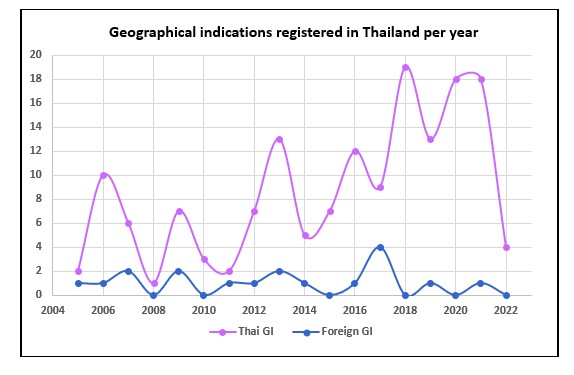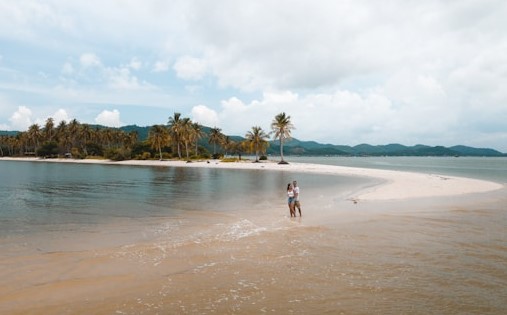An international concept
The origin of geographical indications can be traced back to the 1883 Paris Convention for the Protection of Industrial Property, under the designation of “indications of source” or “appellations of origin”, in an effort to protect as IP assets agricultural and artisanal products that form the traditional, cultural and culinary landscape of countries. Other agreements were made to keep in check the right use of indications of source and appellations of origin (the Madrid Agreement for the Repression of False or Deceptive Indications of Source on Goods in 1891 and the Lisbon Agreement for the Protection of Appellations of Origin and their International Registration in 1958), to which Thailand is not signatory.
The TRIPS Agreement covers rather effectively the matter in its Section 3 on Geographical Indications, defining them as “indications which identify a good as originating in the territory of a Member, or a region or locality in that territory, where a given quality, reputation or other characteristic of the good is essentially attributable to its geographical origin” (Article 22). It also imposes on member States an obligation to provide legal means to prevent misuse of geographical indications, including misuse through trademark registration. Geographical indications for wines and spirits benefit from a specific protection (Article 23).
To approach this somewhat vague concept more clearly, here are a few examples of GIs recognized around the world: Gruyère and Gorgonzola cheeses, Basmati rice, Darjeeling tea, Australian wild abalone, Zhostovo paintings…
How to protect a geographical indication in Thailand?
Geographical indications can be protected by different means. In most countries, like Thailand, a registration system has been set up, allowing for official and formal recognition of geographical indications at the national level. However, the geographical indications can also be protected through the use of certification or collective marks, administrative certification procedures or unfair competition regulations, or a combination of some or all of these methods.
Thailand’s geographical indications’ registration system stems from the 2003 Geographical Indications Protection Act. Its Section 3 gives a definition that overlaps with the definition given by the TRIPS Agreement.[1] The Act also excludes the registration of two types of geographical indications: generic names and indications conflicting with public order, good moral or public policy.[2]
Registration process
Thailand’s geographical indications’ registration system is in place since 2004 and open to foreign geographical indications that are or can be protected in their country of origin.[3]
Three types of persons or entities can apply for registration:[4]
- Government agencies or public companies and entities having a mandate covering geographical origin of goods;
- A person or a juristic person involved in the trade of goods for which a geographical indication is used and having its place of residence/registration where the geographical indication originates;
- A group of consumers using the goods belonging to a geographical indication.
The application must include details relating to the quality and reputation of the goods and the geographical indication.
The application will be processed within four months of the filing date. If it does not comply with the requirements set forth in the Act, the applicant will be notified and will have 90 days to appeal the decision before the Geographical Indications Board.
If it complies with the requirements, the application will be published and any interested party may object to its registration within 90 days from its publication date. If no opposition is filed, the geographical indication will be registered as from the filing date of the application.[5] If an opposition is filed, the counterstatement should be filed within 90 days, failing which the application will be deemed abandoned.
The applicant and the opponent have the right to appeal against the registrar’s decision before the Board of Geographical Indications.
Chapter III of the Act focuses on correction and revocation of registered geographical indications. It is to be noted that geographical indications that become generic overtime can be revoked upon request.[6]
A ministerial regulation clarifies the requirements for the registration of a geographical indication.[7] Foreign applicants must be represented by an authorized person in Thailand through a legalized Power of Attorney. All supporting documents must be translated in Thai (certified translation).
The application must contain the following information: details about the applicant; representation of the geographical indication (name or symbol); description of the goods and their characteristics; information on the connection between the goods and the geographical origin; location of the geographical origin; examples of use of the geographical indication on the goods; and a photograph of the goods.
Misuse of geographical indications & sanctions
If the geographical indication is misused by the producer of the goods for which it has been registered, i.e., not used as per the conditions set forth in the registration and application documents, the registrar may order this person to stop using the indication for up to two years.[8]
Once the geographical indication is registered, other acts that amount to misuse are prohibited by law:
- Use of a geographical indication in a way that misleads others to falsely believe that the goods sold are from the geographical origin that has been registered;
- Use of a geographical indication in a way that causes the public to be confused or misled as to the origin of the goods and to their quality, reputation or other characteristics, with the intention to cause damage to competitors.[9]
These acts are sanctioned by a fine of 200,000 Thai Baht.[10]
In addition, Thai’s geographical indications are also protected indirectly under the following laws:
- Thailand Criminal Code 1956: under Section 271, a person selling goods using inaccurate geographical indications in order to deceive the buyer as to their origin or quality will be sanctioned by three-year imprisonment or a fine of 60,000 Thai Baht, or both.
- Consumer Protection Act 1979: Sections 22 and 47 sanction the use of deceptive advertisements to sell goods, including as to their origin, by six months imprisonment or a fine of 50,000 Thai Baht, or both.
Registered geographical indications in Thailand
At the time of writing this article, a total of 174 geographical indications have been registered with the Thai Department of Intellectual Property: 18 from abroad and 156 for Thai products.

As can be seen in the above chart, in the past decade, the Thai government has scaled up its efforts to protect the value and specificity of Thai products by trying to register at least one geographical indication per Thai province. A few examples of Thai GIs are Phetchabun sweet tamarind, Doi Tung coffee, Chaiya salted eggs, rose apples from Petchaburi, Koh Kret pottery, Koh Phangan coconuts, Khao Yai wine and Sisaket garlic. Thailand’s government also registered a few geographical indications overseas.
Meanwhile, the number of foreign geographical indications remains low. The current foreign geographical indications registered in Thailand, listed by registration dates, are: pisco from Peru (2005), champagne from France (2006), Brunello di Montalcino from Italy and cognac from France (2007), prosciutto di Parma from Italy and scotch whisky from Scotland (2009), Napa Valley from the United States (2011), tequila from Mexico (2012), Barbaresco and Barolo from Italy (2013), Buon Ma Thuot coffee from Vietnam (2014), Parmigiano-Reggiano from Italy (2016), Kampot pepper and Kampong Speu palm sugar from Cambodia and Shan Tuyet Moc Chau tea and Van Yen cinnamon from Vietnam (2017), Grana Padano from Italy (2019) and the most recent, Higashine cherry from Japan, registered in 2021.
A complete updated list is available on the DIP website at the following link:
http://www.ipthailand.go.th/th/gi-015.html
Producers or traders of the goods that benefit from a registered Thai geographical indication can apply for the right to use the geographical indication’s logo or symbol at the DIP. They must provide documents summarizing the production process of the goods. If their application is approved by the Board of Geographical Indications, they will obtain a license to use the logo or symbol for a period of two years.
Written by: Adele Marchal
Research contributor: Thamolwan Insawang
Reviewers: Munif Chaipanya
[1] ““geographical indication” means a name, symbol or any other thing used for calling or representing a geographical origin and capable of identifying that the goods originating in that geographical origin are the goods the particular quality, reputation or characteristic of which is attributable to such geographical origin”.
[2] Section 5 of the 2003 Geographical Indications Protection Act.
[3] Ibid, Section 6.
[4] Ibid, Section 7.
[5] Ibid, Sections 12 to 19.
[6] Ibid, Section 23.
[7] Ministerial Regulation on Rules and Procedures in connection with the Application for Registration, the Publication, the Submission of An Opposition and A Counter-Statement, the Registration, the Appeal, and the Correction or Revocation of the Geographical Indications Registration (2004).
[8] Ibid, Section 26.
[9] Ibid, Section 27.
[10] Ibid, Section 39.







